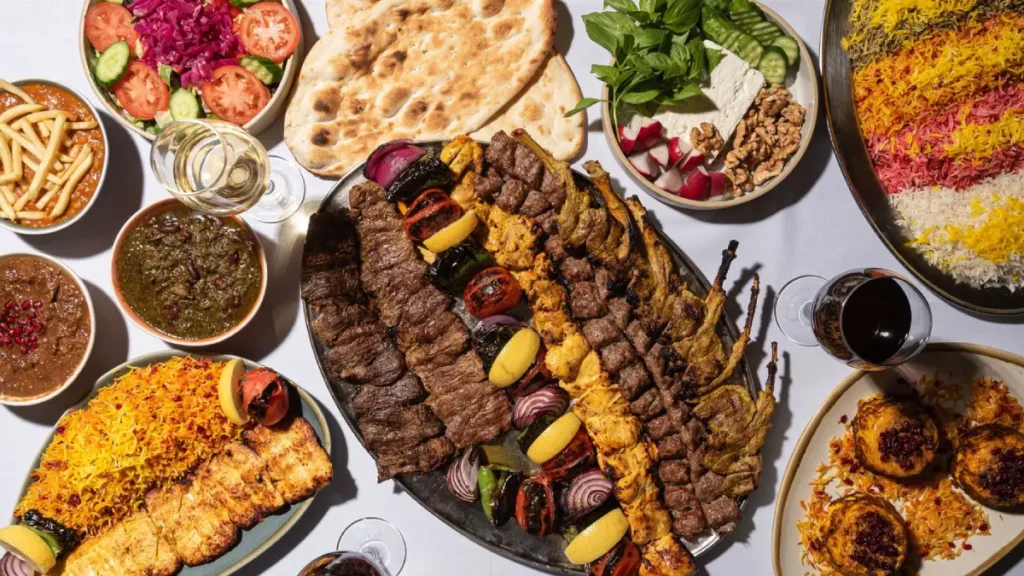Iran and Italy are similar in a great many ways. Despite their linguistic and geographic differences, both countries are strikingly similar in several ways. You may even have heard people saying that Italy is the Iran of Europe, and on the contrary, Iran is the Italy of Asia.
The similarities between Iran and Italy go beyond the color of the flag of both countries, the people of these two countries are very warm and hospitable. But let us delve more into the topic and you will be surprised to learn how similar the two nations are.

Connection to Family
Both Italy and Iran place a high value on family connections, with deep respect for elders and strong familial bonds. In Italy, you will find that family gatherings are frequent and cherished, reflecting a close-knit family structure where even adults maintain tight connections with their parents. Similarly, in Iran, family is central to social life, with respect for elders being a fundamental value.
This deep-rooted respect and affection for family create a strong sense of unity and togetherness in both cultures. Weekend gatherings in both countries are more than just casual meetings; they are crucial moments for family members to reconnect and celebrate their relationships.
Respect for the Elderly
Respect for the elderly is a core value shared by both Italians and Iranians. In both cultures, it is customary to give up your seat on public transport for an older person, reflecting a deep respect for age and wisdom. Families in both countries take great responsibility in caring for elderly relatives, often choosing to live in close proximity or even together to provide support and companionship.
This strong sense of duty towards the elderly highlights a cultural similarity that emphasizes family care and respect across generations. It’s common in both Italy and Iran for families to maintain strong ties with their elders, ensuring they are cared for and respected throughout their lives.

Use of Body Language
Communication in both Italy and Iran goes beyond words, heavily relying on expressive body language. You’ll notice that Italians and Iranians both use animated gestures and facial expressions during conversations, making their interactions lively and engaging. Italians are famous for their hand movements that emphasize their speech, while Iranians also communicate vividly through gestures and expressions.
This non-verbal communication adds a rich layer of meaning to their conversations, making interactions more dynamic and emotionally expressive. Whether it’s discussing daily events or sharing a meal, both Italians and Iranians convey their feelings and intentions through a robust use of body language.
Greeting Traditions
One of the charming similarities is the way people greet each other. Both Italians and Iranians are known for their warm greetings, often involving cheek kisses. However, Italians typically exchange two kisses, while Iranians may offer three. This small difference highlights the affectionate nature of both cultures and can help you navigate social interactions when visiting or interacting with people from either country.

Physical Appearance
It might surprise you to learn that Italians and Iranians share some physical similarities due to common historical influences. Both nations have a genetic background marked by certain traits, such as large eyes, broad eyebrows, and slender cheeks. This shared genetic heritage, influenced by historical migrations and interactions, contributes to similar facial features among people from these countries.
The presence of Haplogroup J2, a genetic marker common in both Italy and Iran, reflects this connection, showing how historical ties have influenced physical characteristics across these regions. This aspect of physical appearance is a fascinating reminder of the interconnectedness of human history.
Rich Historical Heritage of Iran and Italy
Italy and Iran share deep historical roots, with both countries being significant cradles of ancient civilizations. The remnants of these great empires have left indelible marks on their cultures, architecture, and traditions.
Italy has a rich heritage that traces back to the Roman Empire, renowned for its architectural marvels such as the Colosseum and the Pantheon. Similarly, Iran was once the center of the Persian Empire, known for its grand palaces, intricate artwork, and impressive architectural feats like the Persepolis.
Both nations take immense pride in preserving their historical sites and artifacts. Italy’s archaeological wonders like Pompeii and Herculaneum find echoes in Iran’s UNESCO World Heritage sites, including the ancient city of Persepolis and the stunning architecture of Isfahan’s Naqsh-e Jahan Square.

Iranian and Italian Food
The culinary traditions of both Italy and Iran showcase remarkable similarities, with a focus on diverse flavors, fresh ingredients, and the significance of family meals. Also, Italians, like Iranians, take great pride in their cuisine and actively promote it with enthusiasm.
Both countries share common cuisines that have been created with historical and cultural influences. For example, polo or risotto, pasta or noodles, and dolmades.
The two countries also have local and regional cuisines that vary greatly according to geographical, climatic, and seasonal conditions. For example, in Iran and Italy, the food of the north, south, east, and west of the country differs greatly.
Both countries have special occasion foods that are determined by traditions, customs, and beliefs. For example, in Iran, dishes like Sabzi Polo, Ash-e Reshteh, and Khoresh-e Fesenjan are prepared for Nowruz, Shab-e Cheleh, and Shab-e Yalda, respectively. Similarly, Italy features specific foods for Christmas, Easter, Mother’s Day, and New Year’s Eve.
For more information about Iranian traditional foods, read the article: Top 5 Iranian Foods You Don’t Want to Miss.

Drinking Habits
A shared passion for coffee and ice cream is another striking similarity between Italy and Iran. Both cultures appreciate high-quality coffee, with coffee shops becoming increasingly popular in Iran, mirroring the café culture of Italy. Whether it’s an Italian espresso or an Iranian cup of coffee, the enjoyment of a good brew is a common cultural trait.
Iranian Saffron and Italian Gelato
When it comes to ice cream, Iran and Italy each have their distinctive traditions, yet both cultures have seen a blend and internationalization of their iconic frozen treats.
In Iran, traditional ice cream often features saffron, a spice renowned for its rich, aromatic flavor and vibrant yellow color. Saffron ice cream, known as “Bastani,” is a beloved treat in Iran, often enjoyed with hints of rosewater and pistachios. This classic dessert embodies the unique flavors of Persian cuisine, offering a taste that is both exotic and deeply rooted in Iranian culinary traditions.
Italy, on the other hand, is known for its gelato, a creamy and dense frozen dessert that is often more flavorful than traditional ice cream. Italian gelato comes in a myriad of flavors, from classic vanilla and chocolate to more adventurous options like tiramisu and pistachio. The artisanal craft of making gelato has made it a symbol of Italian culture and an international favorite.

Appreciation for Art and Aesthetics
The similarities between Iran and Italy extend beyond culinary traditions. Both nations share a profound appreciation for various art forms, music, literature, and craftsmanship. Throughout history, they have produced exceptional artists, musicians, poets, and architects who have left a lasting impact on the global artistic landscape.
In both Iranian and Italian cultures, traditional arts hold immense significance. Calligraphy, with its intricate and elegant script, is highly regarded in Iran, while Italy boasts a rich tradition of masterful miniature painting and pottery.
Music, too, holds a special place in both societies. Iranians and Italians have contributed greatly to the world of classical, traditional, and contemporary music.
Furthermore, literature plays a vital role in both Iranian and Italian cultures. From renowned poets and novelists to celebrated playwrights, each country boasts a rich literary tradition that reflects their unique histories, perspectives, and artistic prowess.
Love for Fashion
Fashion in Italy and Iran reflects two rich and distinct cultural heritages, each with its own unique sense of style and tradition. While Italy is globally renowned for its cutting-edge fashion industry and luxurious trends, Iran has a vibrant and historically significant fashion scene that continues to evolve and influence modern styles.
Italy’s reputation as a fashion powerhouse is deeply rooted in its long history of elegance and craftsmanship. Cities like Milan, Florence, and Rome are synonymous with high fashion, luxury, and innovation. Milan, in particular, stands out as the fashion capital of the world, hosting prestigious fashion weeks and housing the headquarters of numerous renowned designer brands such as Gucci, Prada, and Versace.
On the other hand, Iranian fashion is rooted in its rich cultural and historical heritage. The garments are often adorned with intricate embroidery and traditional patterns, showcasing Iran’s artistic craftsmanship.
In recent years, Iranian fashion has undergone a remarkable transformation, merging traditional elements with contemporary styles. Designers in Iran are creatively navigating the balance between modern fashion trends and cultural modesty. This has led to a rise in innovative designs that respect cultural norms while embracing global fashion influences.

Warm Hospitality of Iranians and Italians
The warm hospitality of Italians and Iranians is a defining feature of both cultures. In both countries, visitors are welcomed with open arms, often offered meals, drinks, and friendly conversation. This tradition of hospitality extends to sharing time together and making guests feel at home.
Whether you’re invited to an Italian home for a meal or welcomed by an Iranian family, you’ll experience a genuine sense of warmth and generosity. This shared cultural value of hospitality creates memorable experiences for travelers, reflecting a deep-seated tradition of kindness and openness in both Italy and Iran.
Love for Festivals & Celebrations
Italians and Iranians have a vibrant festival culture with numerous traditional celebrations throughout the year. In both countries, these festivities feature captivating elements such as music, dance, colorful costumes, and traditional rituals. Italians and Iranians come together to celebrate their rich heritage, paying homage to centuries-old traditions that have been passed down through generations.
In Italy, events like Carnival and regional festivals highlight local customs and celebrations. In Iran, festivals such as Nowruz and Yalda Night reflect the country’s cultural richness.
By participating in these celebrations, Italians and Iranians strengthen their bonds as a community and celebrate the unique aspects of their respective cultures. The festival culture in both countries serves as a reminder of the power of tradition and the enduring spirit of celebration that unites people across borders.
Leisure Activities
Leisure activities in both Iran and Italy reflect a deep appreciation for socializing and enjoying life with family and friends. In both countries, spending quality time with loved ones is highly valued, and various communal activities are integral to daily life. One prominent similarity is the emphasis on gatherings and social events. These social occasions often involve extensive meals, shared stories, and lively conversations, creating a warm and inviting atmosphere.
Both cultures place a strong emphasis on outdoor and recreational activities. In Iran, popular leisure activities include picnics in nature, hiking in the scenic landscapes of the mountains, and enjoying time at local parks and lakes. Similarly, in Italy, outdoor activities such as strolling through charming piazzas, visiting scenic countryside, and participating in recreational sports are common.
Both cultures also enjoy engaging in sports, with football (soccer) being a prominent shared interest. In Iran, football is immensely popular, and matches often serve as a major social event. Italy, known for its strong football culture, sees a similar enthusiasm for the sport, with local teams and national games drawing significant attention.

Driving Habits and Traffic Culture
Iran and Italy share some notable similarities when it comes to driving and traffic culture, both of which are characterized by lively and sometimes chaotic environments. In both countries, driving can be a challenging experience due to congested roads and a more flexible approach to traffic rules.
Another similarity is the tendency to sometimes skip wearing seat belts, despite laws requiring them. In both countries, it’s not uncommon for drivers to neglect seat belt use, even though enforcement exists and penalties are in place. Additionally, both Iran and Italy deal with traffic jams and road conditions that contribute to heavy congestion, making driving a sometimes stressful experience.
Bottom Line
In exploring the unique wonders of different countries, one cannot help but notice the intriguing similarities that exist within their cultures. Iran and Italy, in particular, exhibit a multitude of cultural parallels that captivate our attention. In this blog, we have highlighted the most striking similarities between Iran and Italy.
However, the shared cultural traits mentioned above merely scratch the surface. The cultural affinity between Iranians and Italians runs deeper, fostering a strong connection that resonates with many individuals.
We hope that the insights shared in this blog have been informative. We invite you to share your experiences of traveling to Italy or Iran below and any other cultural similarities you may have encountered beyond what we have discussed.

